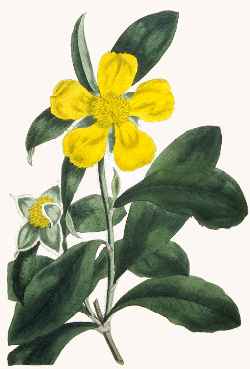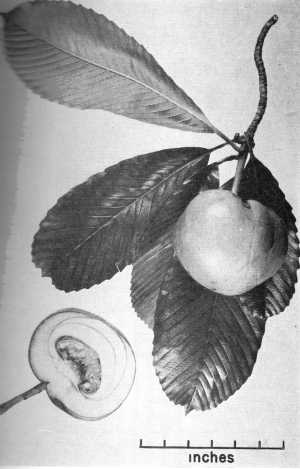Hondapara Tree, Chulta, Elephant Apple
Scientific Name: Dillenia indica L.
Synonym: Dillenia speciosa
Family: Dilleniaceae
Frost Tolerance: Greenhouse tree in Phoenix
Sun Exposure: Full sun to light shade
Origin: India to Borneo & Java
Growth Habits: Tree, up to 25 feet tall (7.5 m)
Watering Needs: Regular water, keep soil moist
Propagation: Seeds, or occasionally cuttings

As Dillenia speciosa in Curtis Botanical Magazine
The Dillenia, native to tropical Asia, forms a handsome ever green tree that is well suited for ornamental purposes. The trunk usually branches a few feet above the ground, forming a spreading tree that reaches a height of 20 to 25 feet (6 to 7.5 m). The oblong or obovate, toothed leaves are up to 12 inches in length (30 cm) and have many conspicuous parallel veins. The leaves are shiny dark green above, light green beneath, and are confined to the ends of the branches.
Blooming Habits:
The beautiful, solitary, white flowers are very large, sometimes measuring 9 inches in diameter (22 cm). After flowering, the petals drop and the persistent calyx again closes and develops to form a thick fleshy covering enveloping the fruit.
Fruiting Habits:
The fruit, together with its protective covering, measures 5 to 6 inches in diameter (12-15 cm). The many-seeded true fruit is greenish yellow and surmounted by the persistent, slender, spreading rays of the stigma. The juicy pulp is aromatic but very acid and requires cooking. Unripe fruits are also cooked and pickled.
Culture:
The dillenia can be propagated readily by seeds but with difficulty from cuttings. It can be grown on many types of soils, but does better on acidic sandy loams.
Desert-Tropicals is dedicated to provide gardening advice, gardening ideas, and information about flower of all kind for landscape and collections.We try to check carefully the identification of the plants on the illustrations as well as the other information from the page, but occasionally errors do occur. if you notice anything that needs to be changed please contact us.Thanks.
© 1998-2020 Philippe Faucon, All Rights Reserved.
